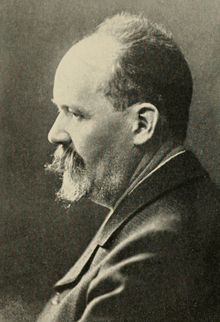Théodore Flournoy
| Théodore Flournoy | |
|---|---|
 | |
| Born |
15 August 1854 Geneva, Switzerland |
| Died |
5 November 1920 (aged 66) Geneva, Switzerland |
| Nationality | Swiss |
| Fields | Psychology |
| Institutions | University of Geneva |
| Known for | Study of spiritism and psychic phenomena |
Théodore Flournoy (15 August 1854 – 5 November 1920)[1] was a professor of psychology at the University of Geneva and author of books on parapsychology and spiritism.
Medium studies
He is best known for his study of the medium Helen Smith (or Hélène Smith - a pseudonym for Catherine Muller) who relayed information about past lives through a trance state,[2] entitled From India To The Planet Mars (1899). Flournoy described her outpourings as the products of cryptamnesia and as 'romances of the subliminal imagination,'[3] - as evidence of the unconscious mind.[4]
His book Spiritism and Psychology (1911) translated by Hereward Carrington claimed more broadly that mediumship could be explained by suggestion and telepathy from the medium's subconscious mind and that there was no evidence for the spirit hypothesis.[5]
Influence
Flournoy was a contemporary of Freud, and his work influenced C. G. Jung's study of another medium - his cousin Hélène Preiswerk - which was turned into Jung's doctoral dissertation in 1902.[6] Jung also used Flournoy's publication of the autosuggestive writings of Miss Frank Miller as the starting-point for his own book Psychology of the Unconscious.[7] Jung was also influenced by Flounoy's concept of a prospective element in the unconscious, laid out most clearly in his 1908 paper on 'Anti-Suicidal Teleological Automatisms', where he argued that last minute visions in suicides confirming the value of living served the (unconscious) purpose of preserving life.[8]
Flournoy was also one of the few scholars of his time to embrace William James' view of the prime reality of non-dual consciousness (which he dubbed "sciousness") as expressed in his essay, Radical Empiricism.[9] He published an introductory work, The Philosophy of William James, in 1911.[10]
See also
References
- ↑ Witzig, J.S. (1982), "Theodore Flournoy: A friend Indeed", J. Anal. Psychol., 27: 131–148, retrieved 31 October 2009
- ↑ Randi, James (1995), An Encyclopedia of Claims, Frauds, and Hoaxes of the Occult and Supernatural, St. Martin's Press, ISBN 0-312-15119-5 (under "automatic writing")
- ↑ Frank McLynn, Carl Gustav Jung (1996) p. 50
- ↑ Anthony Stevens. (1994). Jung. Oxford University Press. p. 13
- ↑ Theodore Flournoy. (1911). Spiritism and Psychology. Harper and Brothers Publishers.
- ↑ Stevens, Anthony (1994): Jung, A very short introduction, Oxford University Press, Oxford & N.Y.
- ↑ Frank McLynn, Carl Gustav Jung (1996) p. 170-1
- ↑ John Kerr, A Dangerous Method (2012) p. 328
- ↑ Bricklin, Jonathan, Ed. (2006): Sciousness, Guilford, CT: Eirini Press, ISBN 978-0-9799989-0-4
- ↑ Frank McLynn, Carl Gustav Jung (1996) p. 146 and p. 565
Further reading
- J. S. Witzig, 'Theodore Flournoy', Journal of Analytical Psychology 27 (1982) 131-48
- R. E. Goldsmith, The Life and Work of Theodore Flournoy (1970)